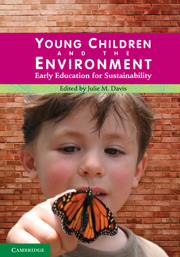Book contents
- Frontmatter
- Foreword
- Contents
- List of contributors
- Introduction
- PART 1
- PART 2
- Chapter 6 Repositioning an ethic of sustainability in early childhood education, with Reconciliation as central
- Chapter 7 The world is flat: ICT and education for sustainability in the early years
- Chapter 8 Healthy and sustainable environments for children and communities
- Chapter 9 Creating deep and broad change through research and systems approaches in early childhood education for sustainability
- Endnote
- Index
- References
Chapter 7 - The world is flat: ICT and education for sustainability in the early years
from PART 2
- Frontmatter
- Foreword
- Contents
- List of contributors
- Introduction
- PART 1
- PART 2
- Chapter 6 Repositioning an ethic of sustainability in early childhood education, with Reconciliation as central
- Chapter 7 The world is flat: ICT and education for sustainability in the early years
- Chapter 8 Healthy and sustainable environments for children and communities
- Chapter 9 Creating deep and broad change through research and systems approaches in early childhood education for sustainability
- Endnote
- Index
- References
Summary
EDITOR'S NOTE
Some readers will think it provocative including a chapter on ICT in a text on ECEfS, especially given the arguments to enhance children's engagement with the natural world. There are recognised equity and access issues – computer technologies are largely artefacts of wealthy economies and societies. In Australia, high-speed internet access is patchy, with people in rural and remote areas generally experiencing poorer-quality services than those in towns and cities.
There are also issues of child safety on the internet: exposure to inappropriate material, cyberbullying and ‘grooming’. Furthermore, the internet is laden with advertisements. Nevertheless, many young children already have access to ICT at home and/or in school or kindergarten. To ignore its existence is naïve. To avoid the modelling of ‘safe’ and appropriate use of the internet is irresponsible. To ignore its potential to enrich learning for sustainability is an opportunity lost. Environmental/sustainability educators already use ICT effectively in schools and universities; such possibilities are now afforded to young children as tools, programs, protocols and teacher abilities in the use of ICT improve.
In this chapter, Margaret Lloyd, a specialist ICT educator, outlines her perspective on the use and potential of ICT in EfS with young children. While the focus is on opportunities for the school-aged child – exemplified by programs and projects tried and tested in classrooms – there are also examples of environmental/sustainability learning using ICT for preschoolers. The focus here is on the use of ICT to reshape learning for new possibilities.
- Type
- Chapter
- Information
- Young Children and the EnvironmentEarly Education for Sustainability, pp. 212 - 241Publisher: Cambridge University PressPrint publication year: 2010
References
- 1
- Cited by

